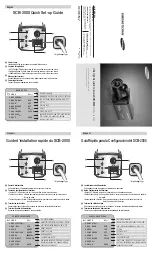
HAM06WS
18.04.2017
©
Velleman nv
4
•
Connect the stand-by battery.
•
Screw the front plate onto the back plate and close the unit.
6.
Connection
•
Telephone line: Connect an existing telephone line to RJ45
connector. Remark: If there is no telephone line connected,
the central will display a message (“PATh TROUBLE”) and
emit a sound when the alarm is triggered. This message can
be deactivated by putting all telephone numbers on “0”
when programming the central unit.
•
Power supply: Connect the included power adapter to the
12VDC/1A input. This power supply will also automatically
charge the internal stand-by battery, which will supply
power when the current is cut off. The central unit will emit
a sound when this internal battery is drained.
•
Terminals 1 through 8:
o
Terminals 1 and 2: 12VDC power supply output. This
output has a constant power of 12V and can be used to
power the external sensors. Attention: terminal 1 = +;
terminal 2 = - (GND).
o
Terminals 3 and 4: Connection for the external siren
(12VDC, 800mA). Attention: terminal 3 = - (GND) (black
wire); terminal 4 = + (red wire).
o
Terminals 5 through 8: Connections for 4 external wired
sensors. These sensors must be of the NC type (NC:
normally closed). Terminal 5 through 8 are assigned to
ARM ZONE 1 through ARM ZONE 4. Connect the second
wire of the sensor to the ground (-) of the central unit (terminal 2 or 3). Wireless sensors will be
assigned to ARM ZONE 5 through ARM ZONE 12.
Important remark concerning terminals 5 through 8:
Connect each unused terminal to the ground (-)
(=terminal 2 or terminal 3) so as to not send false signals to the central unit.
7.
Alarm Unit
a.
Layout
Refer to the illustration on page
2
of this manual.
A
MEDICAL
push to trigger the medical alarm
B
FIRE
push to trigger the fire alarm
C
HELP
push to trigger the help alarm
0 ~ 9
numeric keypad
*
cancel
return to the previous menu and quit the programming mode.
#
confirm
press to confirm an entry
AWAY
press to arm the alarm system
HOME
press to arm only certain programmed zones
SET
press to enter programming mode (only when in disarmed mode)
O
not used
b.
Codes
The system uses 2 security codes which can be modified by the user.
The First code is the
system code
. This code will be used to enter the programming mode of the unit. It is
the most important code since without it the user will not be able to program and to modify other codes.
Keep this code in a secure place. The default value is “000000”.
The second code is the
user code
. This code will be used to deactivate the alarm system (DISARM). The
default value is “1234”.
The unit will enter an alarm status when connecting to the power supply. The message “ARM st” or “DISARM
st” will be displayed. To enter the programming mode or the settings, activate the DISARM mode first.
c.
Deactivating the alarm system (DISARM)
Deactivate the alarm system (DISARM) by entering the user code (default: 1234).
The “DISARM st” message will be displayed and you will hear the vocal message “System disarmed”. Note
that the system will not react to an intrusion trigger signal. It will only react to a SMOKE, GAS or PANIC
signal (24h-alarm).
For security reasons, an alarm engaged with the DELAY function can only be deactivated through the remote
control. When the alarm is activated, e.g. after the delay time has elapsed, it can be deactivated from the
central unit.





































